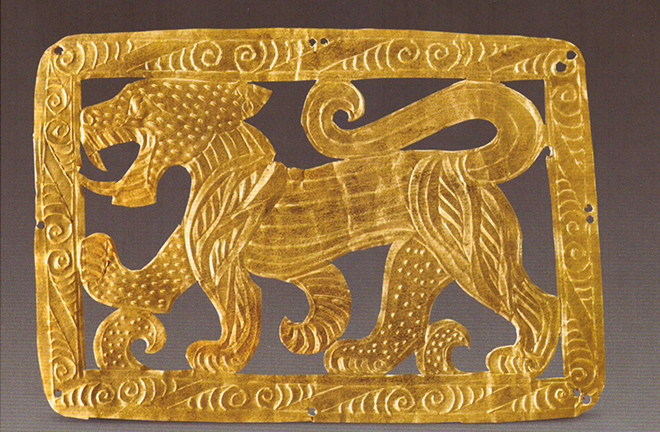Early East-West communication prior to Silk Road

A tiger-patterned belt decoration unearthed at Majiayuan cemetery, Gansu Photo: COURTESY OF BAO SHUGUANG
In the 1st millennium BCE, known as the Early Iron Age in Eurasian history, Zhang Qian had not yet embarked on his mission to Central Asia as the first official envoy from China. During the Late Bronze Age, the agro-pastoral economy of the Eurasian steppe matured, with livestock herds expanding in size, stimulating the emergence of a specialized nomadic economy. Concurrently, the rapid spread of horseback riding significantly enhanced the mobility of steppe populations, enabling closer ties with neighboring cultures. Early nomadic groups maintained close economic and cultural connections with the agricultural societies of the major river basins in the south. Due to their unique nomadic lifestyle, the early nomads played a crucial role as intermediaries between Eastern and Western civilizations.
Early nomadic features
In the 1st millennium BCE, population growth and the expansion of grazing areas intensified competition for grasslands among tribes, leading to frequent wars. During this period, the Eurasian steppe saw the emergence of numerous nomadic tribes characterized by the three Scythian elements: weapons and tools, horse tack, and animal motif art. Similar features were observed in northern China, mainly represented by short swords, horse tack, and animal motif decorations.
This material cultural consistency had a profound impact on the Eurasian steppe. Internal competition among steppe tribes spurred advancements in riding techniques and survival strategies, laying a solid foundation for long-distance trade and cultural exchanges with other civilizations. External exchanges not only enhanced the self-identity of nomadic groups, evident in their remarkably uniform material culture, but also facilitated the continuous adoption of elements from neighboring civilizations. This dual role of the nomadic tribes made them effective communicators and disseminators between Eastern and Western civilizations.
Archaeological evidence
Since no written records of nomadic groups from that period have been found yet, archaeological findings have become the primary basis for exploring nomadic culture. Several significant archaeological sites help outline the role of early nomadic groups as intermediaries in the interactions between neighboring cultures.
In the Altai region of Russia, located at the foothills of central Eurasia, the high-ranking aristocratic tombs of the Pazyryk culture (6th century BCE to 3rd century BCE) yielded numerous artifacts with both Eastern and Western characteristics. These artifacts included items with Eastern features such as Chu-style phoenix patterned saddle blankets, bronze mirrors with the “shan” (“山”) character as the main motif, fragments of Chu-style lacquerware, and four-wheeled high wooden carts. There were also items with Greek and Persian characteristics such as winged griffin figures, carpets with animal predation scenes and lion motifs, and tapestries with Sphinx and tree of life patterns.
In the Hami Hanqigou (after the 6th century BCE) cemetery in Xinjiang, a bronze plaque with double sheep motifs was found. Similar artifacts have also been found in Inner Mongolia and northern Hebei. Additionally, the Alagou cemetery yielded a bronze ritual plate typical of Central Asia and lacquer plates resembling those found in the Han tombs of Mawangdui in China. These discoveries suggest that during that period, Xinjiang was an important hub of cultural exchange between the East and the West.
The Majiayuan cemetery (4th century BCE to 3rd century BCE) in Gansu, China, revealed numerous artifacts with Persian cultural characteristics, such as images or patterns of bighorn sheep and palm leaves, which were likely introduced through Xinjiang by early nomadic groups influenced by Persian culture from Central Asia and nearby regions.
These archaeological findings suggest that during the 1st millennium BCE (especially from the 6th century BCE to the 2nd century BCE), interactions between Persian and Greek civilizations in the West and the Huaxia civilization in the East were frequent. These long-distance interactions were closely related to the expanding range of activities of early nomadic groups in the Eurasian steppe. As the early mediators of cultural exchange between East and West, these nomadic groups spread various technological and cultural elements to the surrounding regions.
Early nomads as intermediaries
According to historical records, many early nomadic groups were active in the Eurasian steppe around the 1st millennium BCE, including the Cimmerians, Scythians, Sarmatians, Arimaspi, Sakas, and Xiongnu. However, archaeological discoveries reveal that these early nomadic cultures were far more complex than historical records suggest. For example, the Issyk kurgan, and the area to its north were inhabited by the “haoma-drinking Sakas,” and played an important role in history as a major route of the Silk Road. Even before the establishment of the Silk Road, these Sakas spread Persian culture to more distant regions through trade and migration.
In north China, winged animal figures appeared from the late Spring and Autumn period to the early Warring States period as a result of the eastward spread of Persian culture. This imagery was likely introduced into China through the migration and trade activities of nomadic tribes. Additionally, certain artifacts, burial customs, and casting techniques discovered around the Qin Shi Huang Mausoleum and Qin cultural sites also bear Western features. Meanwhile, Chinese-style lacquerware, silk textiles, and bronze artifacts discovered in southern Siberia confirm that elements of Central Plains culture had already expanded westward prior to the Silk Road.
Bao Shuguang is an associate professor from the School of History Culture and Tourism at Heilongjiang University.
Edited by REN GUANHONG
